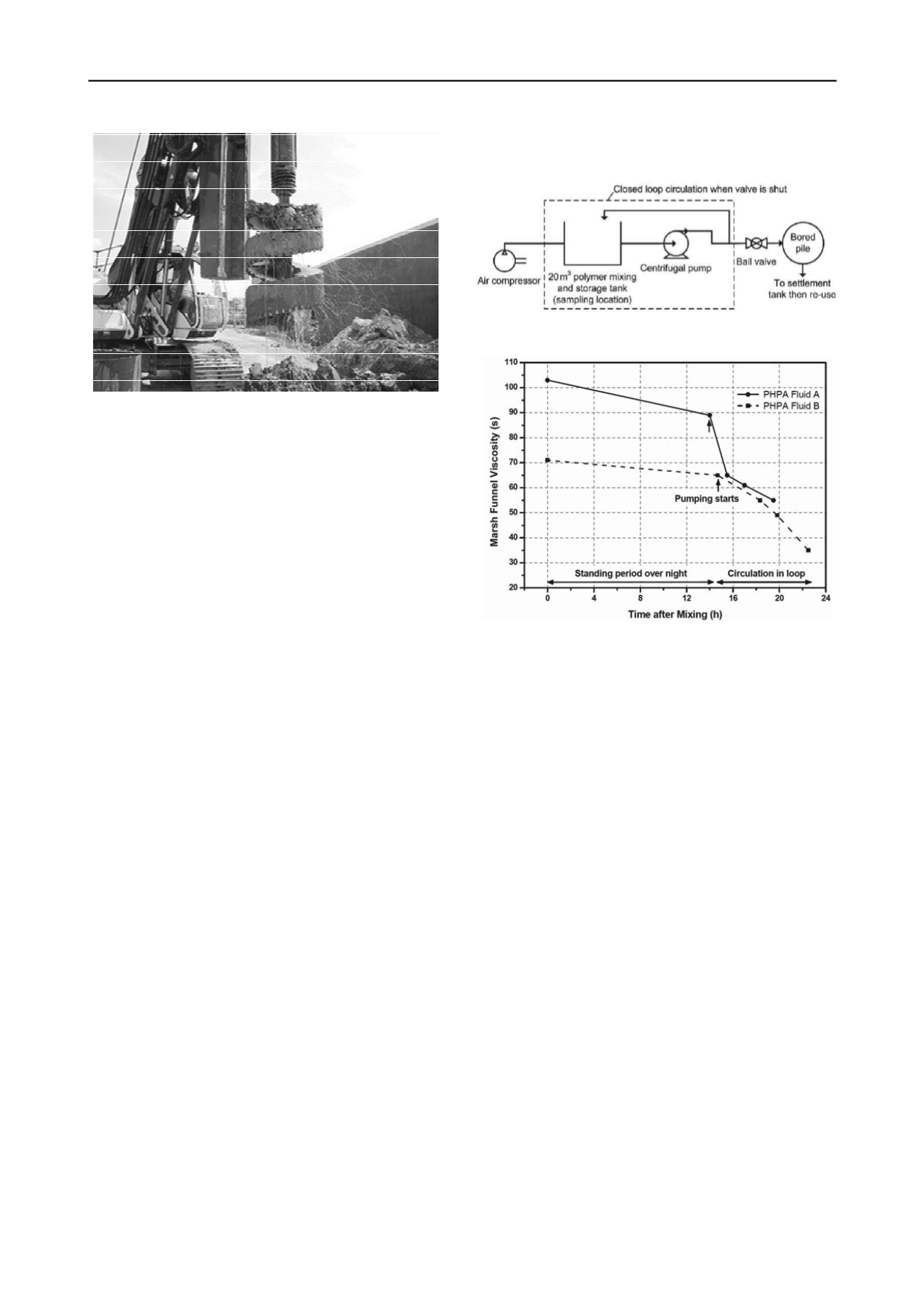
3221
Technical Committee 307 /
Comité technique 307
Figure 3. A twin-flight auger used for the East London trial.
3.1
Failure to use the polymer at the supplier’s recommended
concentration
Suppliers typically recommend that polymer fluids should have
a Marsh funnel viscosity somewhat higher than that for
bentonite slurries. There is therefore a temptation for users to
reduce the polymer concentration and/or for specifiers to require
a lower viscosity. However, the Marsh funnel viscosity of an
excavation fluid is not an indicator of its performance in the
hole rather it is a control parameter to confirm that there is
sufficient active material to develop the required fluid
properties, such as control of fluid loss to the ground,
suspension of cut spoil and inhibition of its dispersion of into
the excavation fluid. Reducing polymer concentration may
compromise fluid performance and should not be attempted.
3.2
Viscosity degradation by fluid recirculation
Lam et al. (2010b) report the results of an investigation of the
effects of continued shear on the properties of polymer fluids.
The work was carried out on-site using a typical bentonite slurry
pipework configuration (Figure 4). The centrifugal pump runs
continuously and the fluid is circulated back to the storage tank
when the valve in the feed line to the excavation is closed so
that the pump need not be repeatedly turned on and off during
the excavation. This is an important aspect of plant operation as
the storage tank may be at some distance from the excavation.
Continuous circulation, although wasteful of energy, is
generally regarded as beneficial for bentonite slurries as it
prevents settlement and improves hydration.
Two commercially available polymer products based
partially hydrolysed polyacrylamides (PHPAs) were used for
the study. Each polymer fluid was prepared in accordance with
the supplier’s recommended procedure and allowed to stand
overnight to ensure stable fluid properties. Recirculation
through the pump system was then started with polymer drawn
off for use in pile bores as required. The Marsh funnel viscosity
of the fluid was measured at intervals and the results are shown
in Figure 5. The overnight drop in viscosity was due to the
escape of fine entrained air bubbles which were present in the
fluids after mixing. The effect of air bubbles on fluid viscosity
is not well recognised and initial viscosities can be mistaken for
working viscosities so leading to under-dosage of polymers.
From Figure 5 it can be seen that once pumping started the
viscosity of each of the fluids dropped and continued to do so
up to the end of the test. Both PHPAs were of high-molecular-
weight (i.e. they were long-chain molecules – longer chain
lengths tend to give higher viscosities) and it seems that the
chains were undergoing scission as a result of continuing shear
in the centrifugal pump and pipework so reducing the fluid
viscosity. Indeed the damage was so severe for Fluid B that the
initial 65 s viscosity (after overnight ageing) had reduced to 35 s
at 22.5 h (after approximately 8 h recirculation) and was tending
to that of pure water (28 s).
Figure 4. Schematic diagram of recirculation/delivery system.
Figure 5. Reduction in viscosity of polymer fluids due to recirculation.
As the fluid was being used for pile excavations the viscosity
was boosted by adding polymer directly to the pile bores to
maintain stability and there were no collapses. However, had
the monitoring programme not been in place, the contractor
would not have been alerted to the problem and the pile bores
might have collapsed due to the excessively low viscosity.
To avoid viscosity reduction due to prolonged shear in
centrifugal pumps, it is recommended that diaphragm pumps are
used as they induce less shear and can be designed to stop
automatically (so also saving energy) when the pressure rises as
a result of closure of the delivery valve. If diaphragm pumps are
not available, fluid recirculation should be minimised.
3.3
Fluid-soil/groundwater incompatibility
The viscosity and hence other properties of PHPA fluids can be
damaged by salts present in mix waters and in the ground. To
investigate the effect of salts in mix water, Lam (2011)
measured the viscosity of several commercial polymer products
over a range of sodium chloride concentrations in the mix water
using an Ubbelohde capillary viscometer. Figure 6 shows some
of the test results. It can be seen that above about 100 mg/litre
sodium chloride, the PHPA fluid lost about 60% of its viscosity
in deionised water whereas the blended polymer lost only about
40%. However, for both fluids there was little further effect up
to 1000 mg/litre. The effects of salts in mix water are
recognised by suppliers and are compensated by increasing the
polymer concentration and raising the solution pH with caustic
alkalis – though increase in pH may give limited benefit.
In saline soils there should be regular monitoring of fluid
viscosity to check for viscosity loss; there are case histories of
collapses. For example, on the Vasco da Gama Bridge in
Portugal two of the piles had to be re-drilled following collapses
which were possibly due to fluid contamination (Bustamante et
al. 1998, KB Technologies Ltd. 2000). Schwarz & Lange
(2004) also report a case history of pile bore collapse due to
high concentrations of salts at a site in Benin. Although simple
PHPAs can be adversely affected by salts, engineered polymer


